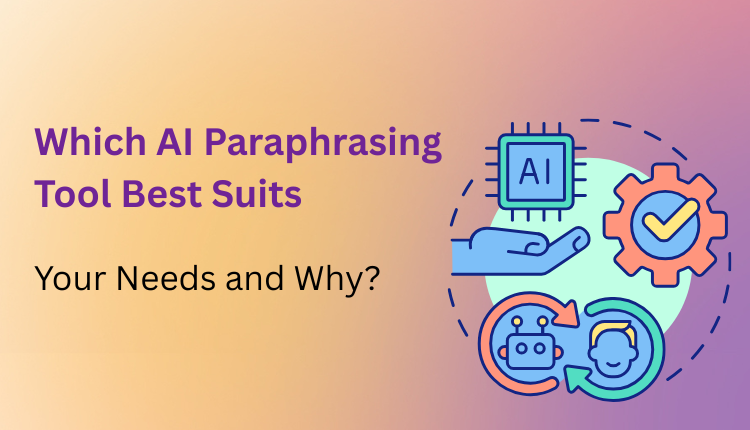As the academic and professional realms evolve rapidly, the importance of maintaining originality and precision in writing has become paramount. AI paraphrasing tools have emerged as essential aids for students, researchers, and professionals, empowering them to craft clear, concise, and plagiarism-free work. These tools simplify complex tasks like rewording dense content, summarizing critical material, and ensuring language refinement. With countless options available today, determining the most suitable paraphrasing tool for your specific needs can be overwhelming.
This blog delves into the significance of AI paraphrasing tool, offers practical tips, evaluates key features, and explores how tools such as Trinka deliver unparalleled support for academics and professionals alike. By following Trinka Writing Style Guide principles, this article empowers you with actionable insights and empathetic advice to elevate your writing.
Understanding the Role of AI Paraphrasing Tools
AI-enhanced paraphrasing tools tackle some of the core concerns within academia and professional communication. These tools go beyond rewording—they are companions in ensuring adherence to high standards of writing while addressing the following:
- Preventing plagiarism effectively in academic or professional work.
- Enhancing accessibility by simplifying jargon and complex language.
- Refining language without losing the author’s original tone.
- Saving valuable time and energy in content creation.
Whether used by students trying to understand intricate research papers or professionals tailoring work for different audiences, these tools have become vital assets. However, not all paraphrasing tools deliver the same results—focusing on choosing one tailored to your unique objectives is essential.
What to Consider When Choosing a Paraphrasing Tool
Selecting an AI paraphrasing tool isn’t a one-size-fits-all process. Here are some factors to guide your decision-making:
- Accuracy: Does the tool capture the context while maintaining the essence of the original content?
- Support for Specialized Language: Can it handle technical, medical, or legal terminology?
- Plagiarism Safeguards: Does it help identify and eliminate plagiarism risks?
- Ease of Use: How user-friendly is the interface, particularly for those less comfortable with technology?
- Customization Options: Are there settings to adjust tone, complexity, or formality?
- Workflow Integration: Can it be linked to tools for manuscript editing or content publishing?
Evaluating these capabilities systematically will help identify a tool that aligns with your specific requirements.
Benefits of Using AI Paraphrasing Tools
- Improved Sentence Clarity: Advanced tools leverage natural language processing to make content clearer while preserving its meaning.
- Plagiarism Prevention: Many paraphrasing platforms incorporate built-in plagiarism detectors, which are crucial for ethical academic and professional writing.
- Time Efficiency: By automating the rewording process, these tools allow users to focus on higher-value tasks like research and idea development.
- Multilingual Flexibility: Some tools offer rephrasing capabilities in multiple languages, making them indispensable for international researchers.
Challenges Associated with AI Paraphrasing Tools
Despite their numerous advantages, AI paraphrasing tools come with limitations:
- Misclassification by AI Detection Tools: Manual proofreading is often required, especially when AI detectors misidentify human paraphrasing attempts as machine generated.
- Bias in Language Models: Training data biases may disadvantage non-native speakers or less common linguistic forms.
- Over-Reliance on Automation: Excessive dependence risks diluting creativity and critical thinking, essential attributes in academic and professional contexts.
By understanding these challenges, users can make judicious use of these tools without overestimating their capabilities.
Trinka: The Premier Choice for Academics and Professionals
Among the growing list of paraphrasing tools, Trinka sets itself apart with its academic focus and customization options for technical and research-based writing. Designed for students, researchers, and enterprise teams, Trinka offers a comprehensive suite of features aligned with industry standards.
Key Trinka Features:
- Advanced Grammar and Style Checks: From complex grammar rules to technical jargon, Trinka ensures unparalleled precision.
- Context-Aware Paraphrasing: Tailored for academic and professional purposes, ensuring tone and originality are maintained.
- AI Content Detection: Minimizes the risk of AI misclassification, critical for publishing high-standard content.
- Plagiarism Detection: Essential for journal submissions, detecting overlaps and ensuring ethical writing practices.
Trinka distinguishes itself in a highly competitive landscape by addressing specific academic needs while offering unparalleled contextual sensitivity.
Why Choose Trinka Over Other Tools?
Trinka isn’t just another paraphrasing tool—it provides targeted solutions for researchers, journal authors, and academic professionals. While general alternatives can handle casual content, Trinka excels in offering domain-specific efficiency. Its unique capabilities, such as tone adaptation and customizable rephrasing, empower users to achieve both precision and impact. As global academic standards become more rigorous, Trinka remains the go-to solution for tackling these challenges head-on.
Maximizing Your Use of Paraphrasing Tools: Pro Tips
- Clarify Your Goal: Decide whether you aim to simplify language, enhance originality, or restructure sentences.
- Review Outputs: Always proofread the paraphrased content to ensure tone consistency and correctness.
- Don’t Overuse: Strike a balance between AI suggestions and your input to retain originality.
- Experiment with Settings: Test customization options to refine tone, complexity, or formal writing styles to your liking.
By integrating tools like Trinka’s Paraphrasing tool into your workflow, you can navigate writing challenges more effectively while maintaining rigorous standards of originality and precision. As you choose the right paraphrasing tool, remember to pair its capabilities with your ethical responsibilities and overarching writing objectives. Optimal collaboration between you and the AI ensures content that is not only impactful but also aligned with professional and academic values.

